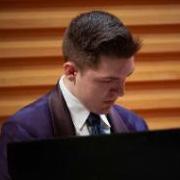All Activity
- Past hour
-
TristanTheTristan started following Romantic Piano Short | Liszt & Chopin Inspired Music
-
Hi there! Nice piece. Critique here. So anyways, make it more difficult and virtuostic. add fast octaves, fast runs, octave glissandos, octave grace notes. chords, and key changes. Don't miss out on tempo changes like in the following way either: Change to dominant with ritarlando, then faster tempo, something like tempo de marcia. Then you can in someway come back to this first theme, or do something else. It is fully your own choice. You could have a clear theme at the start like you had, and 'secretly' bringing the theme back in someway later. (e.g. left hand octaves with the theme while the right plays fast runs or fast arpeggios or something). Try using more contrasts, like from piano, to sforzando. Also, lastly, try avoiding the dominant at the very start. Try first developing the theme, and then going to the dominant. Anyways, good job, and keep on composing!
- 5 replies
-
- piano music
- romantic music
-
(and 2 more)
Tagged with:
- Today
-
Link fixed: Tintinnabuli. (I): Essentials Tintinnabuli (II): T voice Tintinnabuli (III): M voice Tintinnabuli (IV): Adding T voices Tintinnabuli (V): Adding M voices Tintinnabuli (VI): Adding complexity Tintinnabuli (VII): Addendum
-
Henry Ng Tsz Kiu started following Romantic Piano Short | Liszt & Chopin Inspired Music
-
TristanTheTristan started following Idea no.0
-
MP3 Play / pause MY_MUSIC_058_20251104_163157_164052521 0:13 0:13 volume > next menu MY_MUSIC_058_20251104_163157_164052521 > next Does this prelude have like... I don't know... Nine staves?
-
Requiem pro mundo moriente
Alex Weidmann replied to BipolarComposer's topic in Orchestral and Large Ensemble
Not in any great detail no. I do have a score somewhere that shows which passages were completed by Süssmayr. I always feel this is the most contrapuntal of Mozart's major works (not unlike his "Little Fugue"). Seems to me that Handel was a major influence. Some passages from his "Messiah" sound very similar to the Mozart/Süssmayr Requiem. I don't know any of Michael Haydn's works; but I'm sure you're right, and will take a listen. -
I rewrote the piece a bit, added some ornaments, tempo changes, and a few runs. I think this version feels more like it could’ve come from the Romantic era. What do you think?
- 5 replies
-
- 1
-

-
- piano music
- romantic music
-
(and 2 more)
Tagged with:
-
I rewrote the piece a bit, added some ornaments, tempo changes, and a few runs. I think this version feels more like it could’ve come from the Romantic era. What do you think?
- 5 replies
-
- piano music
- romantic music
-
(and 2 more)
Tagged with:
-
JP S. started following Infinity - Marching Band Show
-
Hey Nicholas! I can’t remember if I posted on one of your pieces before, but I also compose marching/pep band pieces and I want to support that as much as I can since there are so few on this forum. Anyway, I think you have some great ideas. Wanting to start with a mellow intro, using different ostinatos and layering them in, entering percussion, then building to a big hit. I think all those ideas are nice. I also like that you had a cohesive vibe throughout the piece. It felt very Tron -esque, robotic and repetitive, and the synth helped that atmosphere. I hesitate to say this, because I think most often this isn’t the highest quality option, but here’s my opinion and taste and you can definitely disagree with me. I think you would write a higher quality piece if you delved into your theme a little more and started from scratch. I say this because sometimes the minimalist, repeated short bits actually come off as boring. My MB did a show that was “minimalist” my Senior year, and it also felt boring and repetitive to me. With your theme of infinity, I think you could easily delve into the idea of moving through time & space endlessly, but in a way there’s still change. Like not an infinity of just repetition (ex. carrying an ostinato throughout the whole piece), but an infinity where a motif is consistently repeated but differently, a canon. You may be able to keep the intro in an ethereal light still, because I think that kind of weightlessness also conveys infinity. Also, something that I hear even DCI writers struggling with is creating a piece that feels like a cohesive whole, including the big hits. The hits often feel not led up to properly, not exited in a fitting way, or they don’t match the overall style of the piece. See what you can do so the hits feel anticipated in some respect, and that they match the style, including tension and resolution. Cheers, and happy composing
-
Thanks for your comment, it helped a lot! The roulades and fioraturas are good ideas!
- 5 replies
-
- 1
-

-
- piano music
- romantic music
-
(and 2 more)
Tagged with:
-
Henry Ng Tsz Kiu started following WIP - First Piano Concerto (Feedback Wanted)
- Yesterday
-
Hey @olivercomposer! Nice piano piece! I don't think it's very Chopinesque or Lisztian - but it certainly sounds like Oliver Kovacs! I think your chord progressions are very unique to you and to your by now well defined cinematic style of composing! If you wanted to make it more Chopinesque you could have included more rubato and long drawn-out roulades or fioraturas. Liszt's piano technique is also quite a bit more difficult. But I really enjoyed this piece of music! Thanks for sharing!
- 5 replies
-
- 1
-

-
- piano music
- romantic music
-
(and 2 more)
Tagged with:
-
Hey @MK_Piano! Great ideas so far! I think what I find confusing about the beginning of your main theme (after the short 4 measure introduction), is that at first it seems like you start the piece on an accompanimental one measure vamp in the strings. So the phrase actually seems to start on measure 6 in the Bassoons. That serves as the antecedent phrase of a musical period. It lasts for 4 measures from bar 6 - 10. That's just fine and dandy, but then the consequent phrase doesn't come in until measure 11 in the Bassoons once again. So it seems like you might be including that one measure vamp again as part of the phrase, in which case it becomes an acephalic five measure phrase. I know Haydn and even sometimes Mozart were known for writing five measure phrases. I am not sure if it is working here. If you are happy with it - definitely keep it! But to me it would sound better if you concatenated the phrasing so that the consequent phrase would start at bar 10. This confusion about the phrase lengths continues into the 2nd iteration of the phrase at measure 18. The phrase starts right on beat one, so this time its not acephalic. But then it continues for five measures from measures 18 - 23 with a slight 3/4 hemiola that's then concatenated to terminate on beat one of measure 23. To me this definitely starts to sound awkward and confusing in the phrasing. When I first listened to the piece without looking at the score, it sounded like you changed meter to 3/4 and then abruptly back to 4/4. I felt lost as a listener, not knowing where the phrase was going rhythmically. So although kinda awesome, the piece does have many structural flaws that confuse (at least this) listener. When the piano comes in on the theme later on in the piece (solo), you do concatenate the phrases to 4 measure phrases and I think that does kinda work better. But I think as far as the big form and macro-tonal plan is concerned, the piece seems to repeat too much. I think if you had included the contrasting 2nd theme in the exposition before doing a 2nd exposition with the piano that would have made more sense. But I have personally never written a piano concerto in sonata form before - I've just written two theme and variations pieces for piano and orchestra. So all my experience is in concertante type piano concerto writing. Thanks for sharing and I hope some of what I had to say was helpful/useful!
-
Requiem pro mundo moriente
Churchcantor replied to BipolarComposer's topic in Orchestral and Large Ensemble
Cool! Have you ever studied the manuscript to see how much of it Mozart actually wrote? Only movement fully orchestrated by Mozart was the first movement, the Introitus. He got about halfway (Hostias/Quam Olim) with only vocal parts, figured bass, and suggestions of first violin figurations. I love it, but prefer to call it the Mozart/Süssmayr Requiem! Highly influenced by Michael Haydn's Requiem, and that one and even Salieri's are worth a listen. Start here: I like Costas Court Composer; he basically writes Haydn symphonies that sound like Haydn, middlin' Haydn anyway. Nice guy, and when I asked if he were Joseph Haydn, or Michael, in a past life, he thought it was pretty funny... -
Requiem pro mundo moriente
Alex Weidmann replied to BipolarComposer's topic in Orchestral and Large Ensemble
By sheer coincidence, I just went to a performance of Mozart's Requiem tonight! -
MK_Piano started following WIP - First Piano Concerto (Feedback Wanted)
-
Hey everyone. I have been going back and forth on my first piano concerto for a long time. Unfortunately, I reached a point where my original design has acted as a roadblock for me to finish the first movement. I decided to restart the work and compose from scratch. I will add more context below, however as an introduction, this excerpt is the entire exposition of my first draft. It is five minutes long and I wish to have it preserved here on YCF. So, sit back, and follow along to the work-in-progress of my first concerto! 🎹 ________________ CONTEXT AND FEEDBACK: I started this project back in June 2024 when I improvised the first theme in one of my practice sessions. I fell in love with it and immediately knew I found a theme worthy for a concerto. I am sticking to late classical (and possible romantic hints) for this work. Hummel, Shostakovich, and Rachmaninoff are the main three sources of inspiration for my orchestration. It follows Sonata-form, however using three themes (1st, 2nd and closing theme) in the exposition. Recently, as I have been diving heavily into the works of Mozart, Haydn and Beethoven, it has dawned on me the level of sophistication each composer had in their writing. How Beethoven would use elements of the first theme to make his second theme, and later use the first movement as basis for theme and variation writing or fugal writing in his third movements. So, after a break in the first half of the year, I have been looking at this exposition and tried to add sophistication. However, I noticed so many gaps in the structure. As it stands, it feels like a compilation of several themes versus one long work showcasing the transformation of the motif and form. As a result, I have stopped working on it and grabbed a blank manuscript and wrote down the key three themes I want to use. I have yet to start rewriting, as I want to give my brain a break and simply ask for feedback. I would appreciate comments on form, orchestration and anything you deem fit. Please do not hesitate to be blunt either! (I may try to write pure double exposition instead of this quasi-expo before the first piano cadenza.) Thanks in advance!! 🙂 _________ EDIT: There is no English Horn in this work so far. I used my Orchestral template and forgot to remove the English Horn from the instrumentation page. Also, The score is NOT TRANSPOSED; it is a concert score)
-
PeterthePapercomPoser started following Requiem in Bb major - Quam Olim II
-
Hey Guys, I hope you are doing well. I really like composers from the Romantic era, like Chopin or Liszt, and I wanted to create a piece of music in that style. Did I nail the feel, or not? Feel free to share what you think! Thanks!
- 5 replies
-
- piano music
- romantic music
-
(and 2 more)
Tagged with:
-
Good news! messing around with piano patterns make a good song! sorry about the quality... Mp3s just aren't that good.
-
Concert performance of my piece for harpsichord
Alex Weidmann replied to Alex Weidmann's topic in Piano Music, Solo Keyboard
Thanks Vince! Heres the programme note I wrote for the concert: My journey into composition began in 2022, guided by a lifelong admiration for Bach and the intricate elegance of the Baroque era. That gravitational pull toward counterpoint and ornamentation shaped the earliest incarnation of this piece: a three-movement work blending electronic synths with orchestral textures, piano, harpsichord, and SATB choir. It was a fusion of old and new, structure and shimmer. Since then, the piece has evolved through several arrangements, each a recalibration of its emotional and sonic architecture. This latest version distills the work into two movements for solo harpsichord, shedding layers while introducing new material that reframes its core motifs. The intention is simple yet vivid: to evoke the image of a sun-dappled forest, where light filters through leaves in shifting patterns, and time feels suspended in golden stillness. I hope the music invites you into that space. N.B. I gave the third movement to the harpsichordist; but she told me it was unplayable: so it wasn't performed. I'm very happy with her interpretation of the other two movements. She played them slower than the tempo I'd imagined; but I think it suited the music very well. -
decided to go back to my first ever song, when I just got FL studio. this was actually made early 2024, but I joined this platform later.
-
No hurry! 🙂
-

2025 Halloween Satisfaction Survey
HoYin Cheung replied to PeterthePapercomPoser's topic in Monthly Competitions
Overall speaking, I quite enjoy the format and atmosphere of this competition. I think the judging mechanism of this competition is good as, 1) Variety of awards/ scoring criteria - It gives recognition to the composers for certain aspects of his music, and allows (specifically growing composers) much specific target/ direction to enhance. Moreover, appreciation to "good" music in some cases where the music is not fitting to the given theme, but is still pleasant to listen to. 2) Qualitative - Please keep the scoring template optional. IMO the scoring template is a benchmark to distinguish the relative performance of each entrants - while the scoring scale may be inconsistent between different judges (i.e. non-linear and subjective), at least that serves as a tool to establish consensus between different judges the rank of each entrants. -

2025 Halloween Satisfaction Survey
Kvothe replied to PeterthePapercomPoser's topic in Monthly Competitions
Hello everyone! My thoughts about the Halloween competition: 1. The scoring sheet help to me to scored each entries as I review them impartially. 2. I think it will be those who are new to grow. 3. There are so many entries, including me, that wrote in different styles. I think if we had a competition that highlight these styles it push members to write new styles. 4. Maybe we can one in the future that monetary reward. But now? 5. For now, let us keep for fun until members mature enough to do official ones. (Even on here) -
Hi all, As some of you may know, I am actively engaging in my composition project for differential festivals. For that reason, I want to adapt into different types of music and add more variety in my project. I chose arranging solo piece to orchestal music to 1) appreciate the style of the composer, and 2) hopefully benefit orchestral work listeners/ writers. Work orchestrated in this post: Piano Sonata in C major, Hob. XVI/50, L.60 Written c. 1794 by Joseph Haydn. This first movement - Allegro, was arranged by me. When I have time, I will share other movement. A side note, I only listened to the piano recording once before I decided to arrange it - perhaps it is a good thing in the sense that I got my interpretation different from pre-existing pianists Thank you for listening! Note: Attached original score for reference. HoYin



.thumb.png.8b5b433a341551e913a34392660bc95b.png)
.thumb.png.1e2763f479362bbb522da50d31ef2e50.png)
